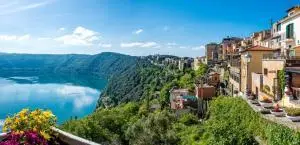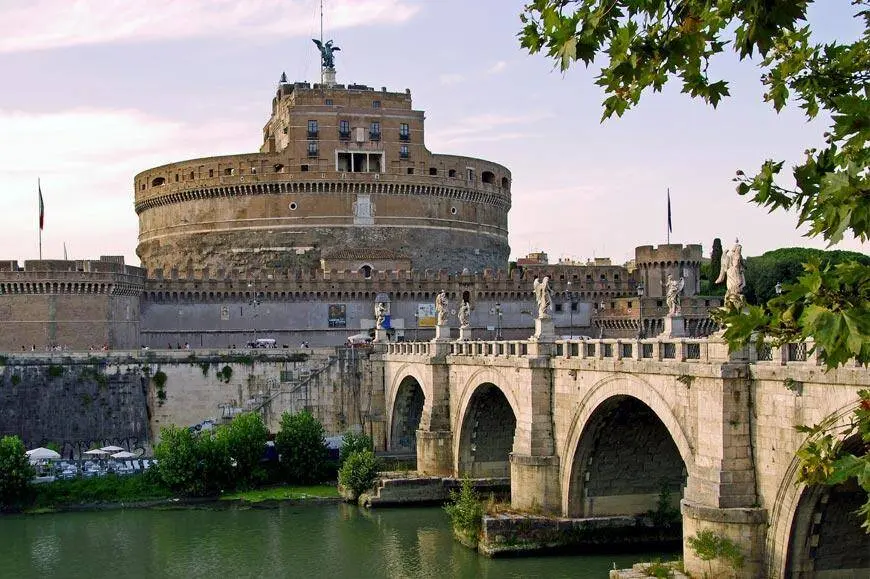Unusual places to visit in Rome
... there are some places hidden outside the mass of tourist circuits...

Rightly considered one of the most fascinating cities in the world, Rome is like an immense and inexhaustible treasure chest full of treasures: a lifetime wouldn’t be enough to know them all. However, in addition to the countless symbolic places and monuments highlighted by traditional guidebooks – the Colosseum, the Trevi Fountain, Piazza San Pietro, Piazza del Popolo, Piazza Venezia, just to mention a few of them – there are some places hidden outside the mass of tourist circuits. These places are little known by the Romans themselves despite representing the authentic spirit of the Eternal City, and which are undoubtedly worth visiting.
In this article Argiletum Tour has selected some of the most significant ones:
- The Coppedè district
- The Little London
- The Pyramid of Cestius and the Non-Catholic Cemetery
- The Bunker of Villa Torlonia
- The Botanical Garden
The Bunker of Villa Torlonia
There’re 3 bunkers under the building of Villa Torlonia, the Roman private residence of Benito Mussolini and family at that time: the anti-aircraft bunker built in 1943 to protect his family in the private residence, the Shelter in the central room of the basement of the Casino Nobile and the Cantina della Villa Shelter, equipped around the middle of 1940. Mussolini ordered the construction of the bomb-proof bunker, safer than the two existing shelters, driven by increasingly frequent aerial bombardments.
After some structural and reclamation interventions, these places, continuously monitored, can welcome visitors in complete safety. The full practicability of the sites, set up with original equipment of the time, allows a guided tour enriched by a multimedia room, photographs and panels that present documents of great historical interest.
The Cantina Shelter
The first room used as a shelter was the cellar under the Fucino Lake, near the Theater. It was equipped with security doors and a gas system hand operated for filtering and regenerating air. The lighting was battery-operated, and the shelter also had a toilet, a telephone with a direct line for Mussolini’s use, first-aid kit, and a box spring with mattress.
The Casino Nobile Shelter
The second shelter was more functional than the Cantina Shelter. It was built in 1941 in the central room of the basement of the Casino Nobile on indications of Mussolini, unhappy with the discomfort of the Cantina Shelter. The rooms were equipped with reinforced concrete walls 120 centimeters thick and an air filtration and circulation system.
The Bunker
The anti-aircraft Bunker has a cross-shaped floor plan and round tunnels protected by a covering in reinforced concrete 4 meters thick. The structure of the armored bunker was dug to a depth of 6 meters and a half below the courtyard in front of Casino Nobile. The Bunker was never finished since Mussolini was discharged and arrested the 25th of July 1943. The armored doors, exterior covering of the chamber, and technological features such as the ventilation system were missing.
The Pyramid of Cestius
Outside the Porta San Paolo is located the bizarre Pyramid of Caius Cestius, a funerary monument that an official responsible for sacred banquets had built for his own burial, between 18 and 12 BC. With its 37 meters high, and its cement coated with marble slabs, it is inspired by Egyptian models, fashionable in Rome after the conquest of Egypt (30 BC). A small door on the West side (opened in the 600s, when the pyramid was brought to light) leads into the tunnel leading to the rectangular funerary cell. The walls are plastered and painted in panels, with chandeliers framing female figures (poorly preserved). In the 3rd century the monument was incorporated into the Aurelian Walls.
The Non-Catholic Cemetery
Just a few steps from the Pyramid of Cestius is “hidden” a little profane gem: The Non-Catholic Cemetery, also known as the Cemetery of the English, built in 1716 to host the graves of the Protestant dead.Over the years, the Non-Catholic Cemetery has been populated with the graves of foreign non-Catholics from all over the world, especially Russians, Orthodox, Muslims and Jews. Among the numerous graves of celebrities, we would point out the graves of John Keats, Percy Bysshe Shelley, Hendrik Christian Andersen, Axel Munthe, August son of Goethe, Carlo Emilio Gadda, Gramsci, Amelia Rosselli, Emilio Lussu, Dario Bellezza, Gregory Corso, Lindsay Kemp, Jannis Kounellis, Miriam Mafai, Luce d’Eramo, Andrea Camilleri. High pines and cypresses surround the paths of this unique place, where different faiths coexist peacefully. The most famous funeral monument is the Angel of Pain, one of the most imitated sculptures in the world, created by the American William Wetmore Story in honor of his wife. The Non-Catholic Cemetery is located in Testaccio, a district famous for its nightlife. Address: Via Caio Cestio, 6
The Coppedè district
The Coppedè district is located between Via Salaria and Via Nomentana, it was built in 1915 by the architect Gino Coppedè by the will of the Società Anonima Edilizia Moderna. Coppedè created an astonishing housing complex almost out of nowhere, small villas with pretty bizarre and singular shapes, cornices and moldings in the manner of imperial Rome, an arch that recalls the triumphal arches … a mixture of Roman architecture, Art Nouveau, Art Decò, Gothic, Baroque and medieval elements. Another city, another dimension.
Several famous directors, such as Dario Argento, have used the Coppedè district as a set for their films.
The Botanical Garden
Located in the heart of Trastevere district since 1883, the Botanical Garden is rightly considered a little piece of Heaven in Rome. It covers an area of about 12 hectares, between Via della Lungara and the Colle del Gianicolo. This archaeological area is known as Horti Getae and in ancient times was composed by the baths of Septimius Severus.
The Botanical Garden of Rome is one of the Museums of the Department of Environmental Biology of the Sapienza University of Rome, an authentic concentrate of distant lands: you can go through Japan, Brazil and Australia, until you reach a garden for the blind people, dominated by the aromas.
The main collections of the Botanical Garden are:
The Gimnosperme, the collection occupies mainly the part of the hilly area
The Bambù, this collection is one of the richest in Europe
The Mediterranean Wood is located in the hilly area and represents a testimony of the vegetation that once covered the Colle del Gianicolo
The Palm trees, is a collection of great importance due to the large number of entities that are grown outdoors
The Rose Garden with a significant collection of wild roses present in Italy
The Garden of Aromas is organized in a series of raised flower beds in masonry that welcome species recognizable by tactile characteristics (for example, the pubescence) or olfactory (aroma) and accompanied by Braille tags
The Valletta of Ferns welcomes a collection of herbaceous ferns
The Mediterranean Garden is organized in flower beds, where you can observe typical species of the Mediterranean scrub
The Orto dei Semplici, with medicinal species organized in raised flower beds. Other medicinal species are cultivated in the surrounding area, while others are still present in the adjacent Tropical Greenhouse
Aquatic plants, the aquatic environment in the Museum is represented by the stream, the pond and some tanks
The Monumental Greenhouse has been home to a collection of euphorbias since 1877, and two climbing plants, Quisqualis indica L. and Petrea volubilis L.
The Corsini Greenhouse, built in the nineteenth century, represents the first warm greenhouse built in the garden. It houses a collection of succulents whose families are mostly represented Cactaceae, Agavaceae, Euphorbiaceae and Crassulaceae. There are also two basins that belonged to Queen Christina of Sweden in the period in which she was staying (from 1659 to 1689) at the Villa Riario, now Palazzo Corsini
The Japanese Garden, was built according to a model of oriental garden, is composed of water features, small waterfalls and two ponds
The Tropical Greenhouse, the collection is a small example of the extraordinary plant biodiversity present in tropical forests
Monumental trees, there are several centenary specimens
Little London
Little London is another of those surprises that conceals the Capital. Hidden among the buildings of Viale del Vignola and Via Flaminia, in the Flaminio district, it is a pedestrian street paved with Sampietrini on which colored houses overlook, with iron gates and railings, carved wooden doors and stone staircases in London style. Everything recalls the districts of the British capital such as Notting Hill, Chelsea and Mayfair.
Private Tours of Rome
-
Modern and Contemporary Rome Tour
Private Day Trips from Rome 165,00€ – 415,00€Book now your detailed tour of contemporary Rome and let yourself be amazed by its architectural wonders!
Rome Italy | Expert Guide | Car&Drive | 6 hours
Add to Cart This product has multiple variants. The options may be chosen on the product page -
Castel Sant’Angelo and the Squares of Rome Private Tour
Private Tours of Rome 94,00€ – 212,00€Enchanting walking tour of the most beautiful Squares of Rome and Castel Sant’Angelo
Rome | Walking Tour | Private Guide | 3 hrs.
Add to Cart This product has multiple variants. The options may be chosen on the product page -
Rome by night Tour and Dining Experience – Private Tour
Holidays in Rome 111,00€ – 249,00€A pleasant walk through the ancient districts of Rome and dinner in an intimate and elegant restaurant in Trastevere
Rome | By night Tour - 2 hrs. | Dinner
Add to Cart This product has multiple variants. The options may be chosen on the product page -
Rome by Night Tour – Private Driver and Guide
Holidays in Rome 116,00€ – 293,00€Welcome to "Rome by Night with Private Driver and Guide"
Rome | By night Tour | Private Car | 2 hrs.
Add to Cart This product has multiple variants. The options may be chosen on the product page -
Bicycle Tour of Rome
City Tours of RomeBicycle Tour of Rome is an alternative way to visit Rome!
Rome | Private Guide | Bicycle | 3 hrs.
-
Shore excursion Civitavecchia Rome
Day Trips from Rome 241,00€ – 645,00€Discover the major attractions of Rome with who live there! Full day Private Tour from Civitavecchia Port to Rome
Advanced reservation PROMO code
Civitavecchia Rome | Guided Tour | Luxury Car | 8/9 hrs.
Add to Cart This product has multiple variants. The options may be chosen on the product page
travel magazine

The 5 most loved Italian dishes in the world
Italy, the birthplace of gastronomy, is universally recognized for its rich and diverse cuisine that reflects centuries of culinary traditions passed down from generation to generation. While not everyone can afford to enjoy Italian dishes in a Michelin-starred restaurant, it is possible to experience the magic of Italian cuisine by preparing some of the most beloved dishes directly at home. Here are the five most loved Italian dishes in the world, along with their recipes and secrets for successfully replicating them in your own kitchen

The Roman Castles, “invisible castles”
The Roman Castles, also known as the “invisible castles”, are historical places located near Rome, famous for their scenic beauty and gourmet food and wine tradition. Despite their rich history and natural attractions, these places often go unnoticed due to Rome’s extraordinary artistic wealth.
The very birth of Rome is linked to the events of Alba Longa, probably the current Castel Gandolfo, founded by Ascanio, son of Aeneas and Creusa in 1230 BC.

Civita di Bagnoregio, Caprarola, Bomarzo – DISCOVERING HIDDEN TREASURES OF ITALY
Italy is a country rich in hidden treasures and captivating destinations where history, art, and natural beauty come together in a unique and unforgettable experience. Among the lesser-known yet equally fascinating gems, Civita di Bagnoregio, Caprarola, and Bomarzo stand out. Let’s discover what makes these places so special.

Wonders of Tuscany: a journey through Art, History and Food and Wine
Located in the heart of Italy, Tuscany is a true treasure to discover. Lush hills, luxurious vineyards, picturesque rural landscapes, historic villas, enchanting medieval cities and an atmosphere of refined timeless beauty have won the hearts of visitors from all over the world.

The Domus Aurea: a hidden masterpiece of Ancient Rome
Built by Emperor Nero in the 1st century AD, the Domus Aurea in Rome is an extraordinary monument that stands as a tangible symbol of the luxury and grandeur of ancient Roman civilization

Guide of Milan for Newbies
Our Quick Guide to Milan for Beginners will accompany you in discovering the treasures of this fascinating and hectic metropolis, providing you with essential information on the main attractions.

Milan: A food and wine experience not to be missed
Milan is much more than a fashion capital; it is also a top culinary destination. With its traditional cuisine, cosmopolitan culinary scene, food markets, and innovation, the city offers a complete eno-gastronomic experience.

Roman coast: a journey through history, sea and unique atmospheres
Discovering the Roman Coastline: A Journey through History, Sea, and Unique Atmospheres by Sarah Strol illustration by franco rea Roman

A Story of Rome
TRAVELS IN SPACETIME A Story of Rome It was a sweltering day in July, with the sun beating down on

Discovering Rome’s “Hidden Treasures”
Discovering the “hidden treasures” of Rome Welcome to a fascinating journey through a less frequented Rome, different from the usual

My Daily Excursions from Rome
“I am always looking for unforgettable experiences, and when I arrived in Rome, I was advised to participate in daily group or private excursions.”

Impossible Rome
a gallery of images to you, created using artificial intelligence on the theme of “Impossible Rome”

The Pantheon, great masterpiece of Roman architecture
Pantheon Contents The Pantheon Great masterpiece of Roman architecture. It is one of the ancient monuments best preserved in the

Fun Activities to do in Rome
for adults and children Fun and Unusual Activities to do in Rome Rome offers a myriad of opportunities to

Villa Adriana in Tivoli, Rome
Villa Adriana – Tivoli, Rome The enormous complex of buildings of Villa Adriana in Tivoli, near Rome, was built (probably

St Peter’s Basilica in Vatican State, Rome
The Basilica of St. Peter in the Vatican City The Basilica of St. Peter is in the heart of the

Rione Monti – the first quarter of Rome
Rione Monti Rome Index Monti, the first quarter of Rome The first quarter of Rome is “Monti” (mounts), so called as

Places Contemporary Rome
The places of contemporary Rome Rome has never stopped adding new architectural layers to its topographic fabric, with works often

Eating in Rome
Eating in Rome! Eating like a God in Rome, Roman food’s survival guide! Index Eating in Rome “Please, recommend us

Why visit Rome
If you love traveling to discover unique places in the world, you must absolutely visit Rome!












